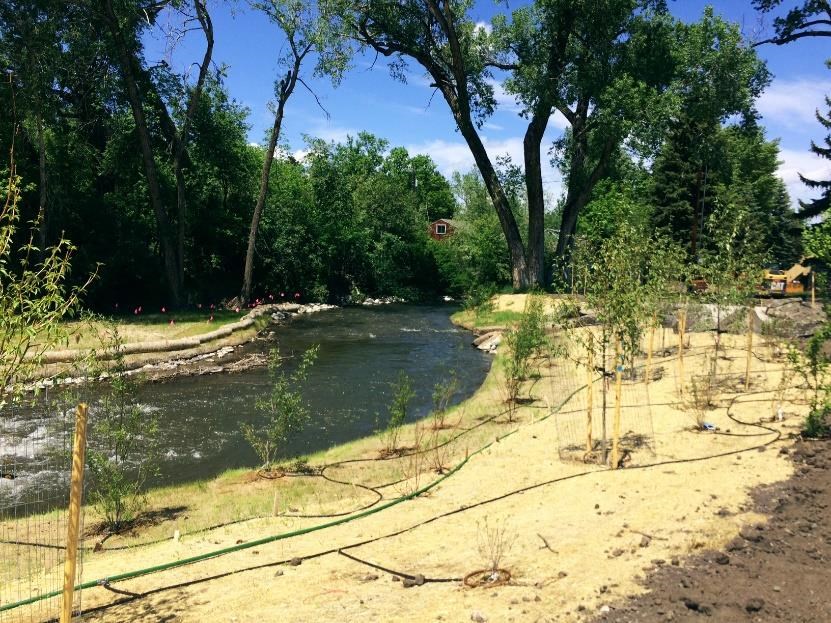Last updated: February 9, 2022
Article
Restoration of an Urban Creek, Park and its Fisheries in Bozeman, Montana

By Christian Gallegos-Alarcón
If you were to take a stroll through the portion of Bozeman Creek that flows through downtown Bozeman, Montana, you would notice the recently improved paths, a beautiful new bridge, lush vegetation, and maybe - if you were especially observant, the increasing fish population.
What would not be obvious, however, is the bioengineering that went into stabilizing and revegetating the floodplain, or how the flow of the creek was strategically altered to restore the aquatic environment. These improvements were the result of six years of work and collaboration between the National Park Service – Rivers, Trails and Conservation Assistance program, the City of Bozeman, Friends of Bogert Park, Gallatin Valley Land Trust and other community stakeholders.

When the community hosted a meeting, professionals from both state and city parks expressed a strong desire to invest in the restoration of Bogert Park, which contains an 800-foot stretch of Bozeman Creek. Gary Weiner, a project specialist for the National Park Service – Rivers, Trails and Conservation Assistance program, was one of the meeting participants. He was familiar with the park’s potential and how it was in desperate need for improvement. Seeing an opportunity for collaboration, the city of Bozeman requested assistance from the National Park Service.
Weiner facilitated a group of stakeholders who quickly determined that the scope of the problem extended beyond Bogert Park. The six-mile stretch of Bozeman Creek that flows through the city needed to be restored. The group established the Bozeman Creek Enhancement Committee and initiated the restoration project for Bogert Park and Bozeman Creek with a goal of meeting the needs of the community.
“[The National Park Service] really was the liaison and the glue that held everybody together and frankly, kept this whole project moving. We needed the National Park Service and in particular Gary Weiner’s experience and expertise,” said Mitch Overton, the director of Parks and Recreation for the City of Bozeman. “He had the ability to bring together folks from the city, local individuals, people concerned about fish habitat, and those interested in water quality - just this wide breadth of people.”

The portion of the creek flowing through downtown Bozeman, Montana, was the most impaired. Its banks had been narrowed and straightened and the riparian vegetation was reduced to a thin line or completely removed. In some areas, the creek flows beneath streets and buildings leading to significant flooding and impacting its ability to handle storm water runoff.
Additionally, as the population of Bozeman began to grow, the city armored the banks with concrete and rock to accommodate development. Bogert Park was located on one of the most altered and impaired portions of the creek – not only was it inaccessible and limited in providing outdoor recreational opportunities, but the fish population dwindled because of the poor natural habitat. The Bozeman Creek Enhancement Plan was designed to provide solutions to these challenges.
The Bozeman Creek Enhancement Committee ensured that the public was involved throughout the plan development process by convening public workshops, conducting a public opinion survey and hosting public events. They also engaged neighborhood associations, conservation groups and local service clubs. The plan as envisioned by the public, was adopted by the Bozeman City Commission in 2012 and outlines goals and strategies to improve the natural environment and recreational values of the six-mile stretch of Bozeman Creek.

Through the City of Bozeman’s Trails, Open Space and Parks Bond, the community was able to secure funding to support the implementation of the plan. The $600,000 bond was allocated for restoration efforts. An additional $20,000 was raised from the city’s Park Improvement Grant which the Friends of Bogert Park then matched.
While there was broad public support for the project, it did not come without unique land ownership challenges. The west side of the bank was privately owned, some landowners mistrusted the city and others were absent. Weiner worked with each landowner to understand their perspectives and address their concerns about how the project might impact their property. An engineering firm was able to develop a design concept that worked with and met stakeholder needs for safe outdoor recreation access and healthy fish and wildlife habitats. Developing relationships with landowners was an instrumental step in moving the project forward.
Bozeman Creek restoration involved reconstruction of the creek’s channel to slow the flow of the creek, filter storm water runoff and improve public safety. The banks were also stabilized with diverse native plants that strengthen the riparian zone.

Another goal of the project was to enhance conditions for desired aquatic species in each stage of their lives and to provide corridor spaces that could sustain that habitat. Deep pools within the creek were constructed for fish to survive winters, boulders were installed to encourage safe resting sites and gravel was added to enhance spawning conditions. Stacked stones were also placed on the outside banks of pools and configured to provide cover for trout.
Increasing the community’s recreational access to the creek was also a priority for the project. New park amenities such as trails and an improved footbridge enhanced the access and values of this natural environment. Today, Bogert Park and Bozeman Creek provides residents with opportunities to fish and relax in this natural space in the heart of the city while also providing a vital ecosystem for wildlife.
In June 2017, the community celebrated the completion of the Bozeman Creek at Bogert Park with a ribbon cutting ceremony.

“Generations before us had thought the way that nature had created the creek was inconvenient and in the way, whereas current generations see that degradation to water quality, fish habitat and the dangers and say ‘hey, nature had this right to begin with, lets engineer it to be the way nature intended it,’” Overton said.
